Dell Latitude 3190 Service manual

Latitude 3190 2-in-1
Owner’s Manual
Regulatory Model: P26T
Regulatory Type: P26T003

Notes, cautions, and warnings

 NOTE: A NOTE indicates important information that helps you make better use of your product.
NOTE: A NOTE indicates important information that helps you make better use of your product.
 CAUTION: A CAUTION indicates either potential damage to hardware or loss of data and tells you how to avoid the problem.
CAUTION: A CAUTION indicates either potential damage to hardware or loss of data and tells you how to avoid the problem.

 WARNING: A WARNING indicates a potential for property damage, personal injury, or death.
WARNING: A WARNING indicates a potential for property damage, personal injury, or death.
© 2018 2019 Dell Inc. or its subsidiaries. All rights reserved. Dell, EMC, and other trademarks are trademarks of Dell Inc. or its subsidiaries. Other trademarks may be trademarks of their respective owners.
2020 - 01
Rev. A01

Contents
1 Chassis view................................................................................................................................ |
6 |
Front open view..................................................................................................................................................................... |
6 |
Left view................................................................................................................................................................................. |
7 |
Right view............................................................................................................................................................................... |
7 |
Palm rest view........................................................................................................................................................................ |
8 |
Bottom view........................................................................................................................................................................... |
9 |
Major components of your system.................................................................................................................................... |
10 |
2 Working on your computer........................................................................................................... |
12 |
Safety precautions............................................................................................................................................................... |
12 |
Electrostatic discharge—ESD protection................................................................................................................... |
12 |
ESD field service kit ...................................................................................................................................................... |
13 |
Transporting sensitive components............................................................................................................................. |
14 |
Before working inside your computer................................................................................................................................ |
14 |
After working inside your computer................................................................................................................................... |
14 |
3 Disassembly and reassembly........................................................................................................ |
15 |
Recommended tools............................................................................................................................................................ |
15 |
Screw size list....................................................................................................................................................................... |
15 |
Base cover............................................................................................................................................................................ |
15 |
Removing base cover.................................................................................................................................................... |
15 |
Installing base cover....................................................................................................................................................... |
17 |
Battery................................................................................................................................................................................... |
17 |
Lithium-ion battery precautions.................................................................................................................................... |
17 |
Removing battery........................................................................................................................................................... |
17 |
Installing battery............................................................................................................................................................. |
18 |
Keyboard lattice and Keyboard.......................................................................................................................................... |
19 |
Removing keyboard........................................................................................................................................................ |
19 |
Installing keyboard.......................................................................................................................................................... |
21 |
M.2 SSD card....................................................................................................................................................................... |
22 |
Removing M.2 Solid State Drive.................................................................................................................................. |
22 |
Installing M.2 Solid State Drive ................................................................................................................................... |
22 |
Power switch board............................................................................................................................................................ |
23 |
Removing power switch board.................................................................................................................................... |
23 |
Installing power switch board....................................................................................................................................... |
23 |
Audio board.......................................................................................................................................................................... |
24 |
Removing audio board................................................................................................................................................... |
24 |
Installing audio board..................................................................................................................................................... |
24 |
Touchpad ............................................................................................................................................................................. |
25 |
Removing touchpad...................................................................................................................................................... |
25 |
Installing the touchpad.................................................................................................................................................. |
27 |
Power connector port......................................................................................................................................................... |
27 |
Removing power connector port................................................................................................................................. |
27 |
Installing power connector port................................................................................................................................... |
28 |
Contents 3
Coin-cell battery.................................................................................................................................................................. |
28 |
Removing coin cell battery........................................................................................................................................... |
28 |
Installing coin cell battery.............................................................................................................................................. |
29 |
Speaker................................................................................................................................................................................. |
29 |
Removing speakers ...................................................................................................................................................... |
29 |
Installing speakers........................................................................................................................................................... |
31 |
Display assembly................................................................................................................................................................... |
31 |
Removing display assembly........................................................................................................................................... |
31 |
Installing display assembly............................................................................................................................................. |
33 |
Display back cover............................................................................................................................................................... |
33 |
Removing display back cover....................................................................................................................................... |
33 |
Installing display back cover......................................................................................................................................... |
35 |
System board....................................................................................................................................................................... |
35 |
Removing system board............................................................................................................................................... |
35 |
Installing system board.................................................................................................................................................. |
38 |
World facing camera........................................................................................................................................................... |
39 |
Removing world facing camera................................................................................................................................... |
39 |
Installing world facing camera...................................................................................................................................... |
39 |
Palm rest............................................................................................................................................................................... |
40 |
Replacing the palm rest................................................................................................................................................ |
40 |
4 Technical specifications.............................................................................................................. |
42 |
Processor.............................................................................................................................................................................. |
42 |
Memory................................................................................................................................................................................. |
42 |
Storage................................................................................................................................................................................. |
43 |
Audio specifications............................................................................................................................................................. |
43 |
Video..................................................................................................................................................................................... |
43 |
Camera.................................................................................................................................................................................. |
43 |
Communications.................................................................................................................................................................. |
44 |
Ports and connectors.......................................................................................................................................................... |
44 |
Display................................................................................................................................................................................... |
44 |
Keyboard............................................................................................................................................................................... |
45 |
Touchpad.............................................................................................................................................................................. |
45 |
Battery.................................................................................................................................................................................. |
45 |
Power adapter..................................................................................................................................................................... |
46 |
Dimensions and weight....................................................................................................................................................... |
46 |
5 Technology and components....................................................................................................... |
47 |
DDR4..................................................................................................................................................................................... |
47 |
USB features........................................................................................................................................................................ |
48 |
HDMI 1.4............................................................................................................................................................................... |
50 |
6 System setup options.................................................................................................................. |
51 |
Boot Sequence..................................................................................................................................................................... |
51 |
Navigation keys.................................................................................................................................................................... |
51 |
System Setup overview...................................................................................................................................................... |
52 |
Accessing System Setup.................................................................................................................................................... |
52 |
General screen options....................................................................................................................................................... |
52 |
System Configuration screen options............................................................................................................................... |
53 |
4 Contents
Video screen options........................................................................................................................................................... |
53 |
Security screen options...................................................................................................................................................... |
54 |
Secure Boot screen options............................................................................................................................................... |
55 |
Intel Software Guard Extensions screen options............................................................................................................ |
55 |
Performance screen options.............................................................................................................................................. |
56 |
Power management screen options................................................................................................................................. |
56 |
POST behavior screen options.......................................................................................................................................... |
57 |
Virtualization support screen options............................................................................................................................... |
58 |
Wireless screen options...................................................................................................................................................... |
58 |
Maintenance screen options.............................................................................................................................................. |
58 |
System logs screen options............................................................................................................................................... |
58 |
SupportAssist system resolution....................................................................................................................................... |
59 |
Updating the BIOS in Windows ........................................................................................................................................ |
59 |
System and setup password.............................................................................................................................................. |
59 |
Assigning a system setup password........................................................................................................................... |
60 |
Deleting or changing an existing system setup password........................................................................................ |
60 |
7 Software.................................................................................................................................... |
61 |
Operating system configurations....................................................................................................................................... |
61 |
Downloading drivers............................................................................................................................................................. |
61 |
8 Troubleshooting......................................................................................................................... |
62 |
Enhanced Pre-Boot System Assessment — ePSA diagnostics................................................................................... |
62 |
Running the ePSA Diagnostics.................................................................................................................................... |
62 |
Real Time Clock reset......................................................................................................................................................... |
62 |
9 Contacting Dell.......................................................................................................................... |
64 |
Contents 5

1
Chassis view
Front open view
1. |
Camera |
2. |
Camera status light |
3. |
Microphone |
4. |
LCD panel |
6 Chassis view
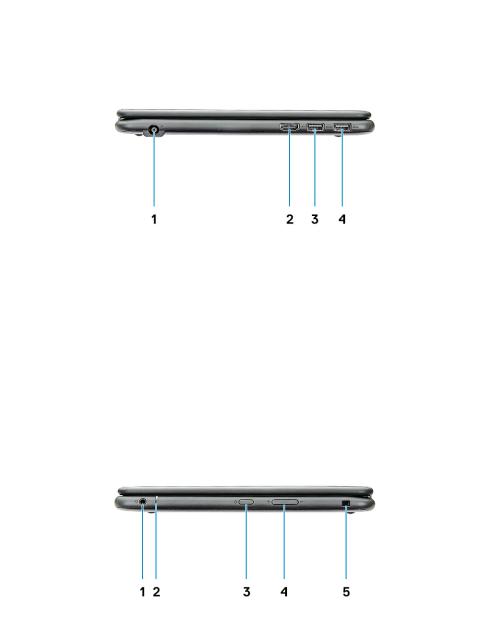
Left view
1. |
Power connector port |
2. |
HDMI port |
3. |
USB 3.1 Gen1 port with PowerShare |
4. |
USB 3.1 Gen1 port |
Right view
1. |
Universal audio jack |
2. |
Battery status light |
3. |
Power button |
4. |
Volume control button |
5. |
Noble wedge lock slot |
|
|
Chassis view |
7 |
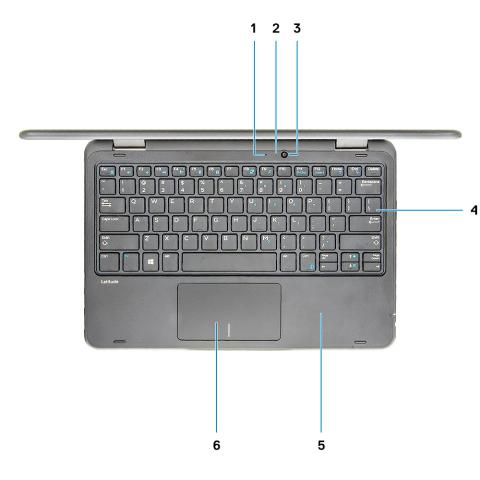
Palm rest view
1. |
World-facing microphone |
2. |
World-facing camera status light |
3. |
World-facing camera |
4. |
Keyboard |
5. |
Palm rest |
6. |
Touchpad |
8 Chassis view

Bottom view
1.Service tag location
2.Speakers
Chassis view |
9 |

Major components of your system
1.Base cover
2.System board
3.Battery
4.Speaker
5.Touchpad metal bracket
6.Palmrest
7.Touchpad
10 Chassis view

8.Display assembly
9.Audio board
10.Power switch board
11.M.2 Solid State Drive
12.Coin cell battery
NOTE: Dell provides a list of components and their part numbers for the original system configuration purchased. These parts are available according to warranty coverages purchased by the customer. Contact your Dell sales representative for purchase options.
Chassis view |
11 |

2
Working on your computer
Topics:
•Safety precautions
•Before working inside your computer
•After working inside your computer
Safety precautions
The safety precautions chapter details the primary steps to be taken before performing any disassembly instructions.
Observe the following safety precautions before you perform any installation or break/fix procedures involving disassembly or reassembly:
•Turn off the system and all attached peripherals.
•Disconnect the system and all attached peripherals from AC power.
•Disconnect all network cables, telephone, and telecommunications lines from the system.
•Use an ESD field service kit when working inside any notebook to avoid electrostatic discharge (ESD) damage.
•After removing any system component, carefully place the removed component on an anti-static mat.
•Wear shoes with non-conductive rubber soles to reduce the chance of getting electrocuted.
Standby power
Dell products with standby power must be unplugged before you open the case. Systems that incorporate standby power are essentially powered while turned off. The internal power enables the system to be remotely turned on (wake on LAN) and suspended into a sleep mode and has other advanced power management features.
Unplugging, pressing and holding the power button for 15 seconds should discharge residual power in the system board.
Bonding
Bonding is a method for connecting two or more grounding conductors to the same electrical potential. This is done through the use of a field service electrostatic discharge (ESD) kit. When connecting a bonding wire, ensure that it is connected to bare metal and never to a painted or non-metal surface. The wrist strap should be secure and in full contact with your skin, and ensure that you remove all jewelry such as watches, bracelets, or rings prior to bonding yourself and the equipment.
Electrostatic discharge—ESD protection
ESD is a major concern when you handle electronic components, especially sensitive components such as expansion cards, processors, memory DIMMs, and system boards. Very slight charges can damage circuits in ways that may not be obvious, such as intermittent problems or a shortened product life span. As the industry pushes for lower power requirements and increased density, ESD protection is an increasing concern.
Due to the increased density of semiconductors used in recent Dell products, the sensitivity to static damage is now higher than in previous Dell products. For this reason, some previously approved methods of handling parts are no longer applicable.
Two recognized types of ESD damage are catastrophic and intermittent failures.
•Catastrophic – Catastrophic failures represent approximately 20 percent of ESD-related failures. The damage causes an immediate and complete loss of device functionality. An example of catastrophic failure is a memory DIMM that has received a static shock and immediately generates a "No POST/No Video" symptom with a beep code emitted for missing or nonfunctional memory.
•Intermittent – Intermittent failures represent approximately 80 percent of ESD-related failures. The high rate of intermittent failures means that most of the time when damage occurs, it is not immediately recognizable. The DIMM receives a static shock, but the tracing is merely weakened and does not immediately produce outward symptoms related to the damage. The weakened trace may take weeks or months to melt, and in the meantime may cause degradation of memory integrity, intermittent memory errors, etc.
12 Working on your computer
The more difficult type of damage to recognize and troubleshoot is the intermittent (also called latent or "walking wounded") failure.
Perform the following steps to prevent ESD damage:
•Use a wired ESD wrist strap that is properly grounded. The use of wireless anti-static straps is no longer allowed; they do not provide adequate protection. Touching the chassis before handling parts does not ensure adequate ESD protection on parts with increased sensitivity to ESD damage.
•Handle all static-sensitive components in a static-safe area. If possible, use anti-static floor pads and workbench pads.
•When unpacking a static-sensitive component from its shipping carton, do not remove the component from the anti-static packing material until you are ready to install the component. Before unwrapping the anti-static packaging, ensure that you discharge static electricity from your body.
•Before transporting a static-sensitive component, place it in an anti-static container or packaging.
ESD field service kit
The unmonitored Field Service kit is the most commonly used service kit. Each Field Service kit includes three main components: antistatic mat, wrist strap, and bonding wire.
Components of an ESD field service kit
The components of an ESD field service kit are:
•Anti-Static Mat – The anti-static mat is dissipative and parts can be placed on it during service procedures. When using an antistatic mat, your wrist strap should be snug and the bonding wire should be connected to the mat and to any bare metal on the system being worked on. Once deployed properly, service parts can be removed from the ESD bag and placed directly on the mat. ESDsensitive items are safe in your hand, on the ESD mat, in the system, or inside a bag.
•Wrist Strap and Bonding Wire – The wrist strap and bonding wire can be either directly connected between your wrist and bare metal on the hardware if the ESD mat is not required, or connected to the anti-static mat to protect hardware that is temporarily placed on the mat. The physical connection of the wrist strap and bonding wire between your skin, the ESD mat, and the hardware is known as bonding. Use only Field Service kits with a wrist strap, mat, and bonding wire. Never use wireless wrist straps. Always be aware that the internal wires of a wrist strap are prone to damage from normal wear and tear, and must be checked regularly with a wrist strap tester in order to avoid accidental ESD hardware damage. It is recommended to test the wrist strap and bonding wire at least once per week.
•ESD Wrist Strap Tester – The wires inside of an ESD strap are prone to damage over time. When using an unmonitored kit, it is a best practice to regularly test the strap prior to each service call, and at a minimum, test once per week. A wrist strap tester is the best method for doing this test. If you do not have your own wrist strap tester, check with your regional office to find out if they have one. To perform the test, plug the wrist-strap's bonding-wire into the tester while it is strapped to your wrist and push the button to test. A green LED is lit if the test is successful; a red LED is lit and an alarm sounds if the test fails.
•Insulator Elements – It is critical to keep ESD sensitive devices, such as plastic heat sink casings, away from internal parts that are insulators and often highly charged.
•Working Environment – Before deploying the ESD Field Service kit, assess the situation at the customer location. For example, deploying the kit for a server environment is different than for a desktop or portable environment. Servers are typically installed in a rack within a data center; desktops or portables are typically placed on office desks or cubicles. Always look for a large open flat work area that is free of clutter and large enough to deploy the ESD kit with additional space to accommodate the type of system that is being repaired. The workspace should also be free of insulators that can cause an ESD event. On the work area, insulators such as Styrofoam and other plastics should always be moved at least 12 inches or 30 centimeters away from sensitive parts before physically handling any hardware components
•ESD Packaging – All ESD-sensitive devices must be shipped and received in static-safe packaging. Metal, static-shielded bags are preferred. However, you should always return the damaged part using the same ESD bag and packaging that the new part arrived in. The ESD bag should be folded over and taped shut and all the same foam packing material should be used in the original box that the new part arrived in. ESD-sensitive devices should be removed from packaging only at an ESD-protected work surface, and parts should never be placed on top of the ESD bag because only the inside of the bag is shielded. Always place parts in your hand, on the ESD mat, in the system, or inside an anti-static bag.
•Transporting Sensitive Components – When transporting ESD sensitive components such as replacement parts or parts to be returned to Dell, it is critical to place these parts in anti-static bags for safe transport.
ESD protection summary
It is recommended that all field service technicians use the traditional wired ESD grounding wrist strap and protective anti-static mat at all times when servicing Dell products. In addition, it is critical that technicians keep sensitive parts separate from all insulator parts while performing service and that they use anti-static bags for transporting sensitive components.
Working on your computer |
13 |

Transporting sensitive components
When transporting ESD sensitive components such as replacement parts or parts to be returned to Dell, it is critical to place these parts in anti-static bags for safe transport.
Lifting equipment
Adhere to the following guidelines when lifting heavy weight equipment:

 CAUTION: Do not lift greater than 50 pounds. Always obtain additional resources or use a mechanical lifting device.
CAUTION: Do not lift greater than 50 pounds. Always obtain additional resources or use a mechanical lifting device.
1.Get a firm balanced footing. Keep your feet apart for a stable base, and point your toes out.
2.Tighten stomach muscles. Abdominal muscles support your spine when you lift, offsetting the force of the load.
3.Lift with your legs, not your back.
4.Keep the load close. The closer it is to your spine, the less force it exerts on your back.
5.Keep your back upright, whether lifting or setting down the load. Do not add the weight of your body to the load. Avoid twisting your body and back.
6.Follow the same techniques in reverse to set the load down.
Before working inside your computer
1.Ensure that your work surface is flat and clean to prevent the computer cover from being scratched.
2.Turn off your computer.
3.If the computer is connected to a docking device (docked), undock it.
4.Disconnect all network cables from the computer (if available).
 CAUTION: If your computer has an RJ45 port, disconnect the network cable by first unplugging the cable from your computer.
CAUTION: If your computer has an RJ45 port, disconnect the network cable by first unplugging the cable from your computer.
5.Disconnect your computer and all attached devices from their electrical outlets.
6.Open the display.
7.Press and hold the power button for few seconds, to ground the system board.
 CAUTION: To guard against electrical shock unplug your computer from the electrical outlet before performing Step
CAUTION: To guard against electrical shock unplug your computer from the electrical outlet before performing Step
#8.
 CAUTION: To avoid electrostatic discharge, ground yourself by using a wrist grounding strap or by periodically touching an unpainted metal surface at the same time as touching a connector on the back of the computer.
CAUTION: To avoid electrostatic discharge, ground yourself by using a wrist grounding strap or by periodically touching an unpainted metal surface at the same time as touching a connector on the back of the computer.
8. Remove any installed ExpressCards or Smart Cards from the appropriate slots.
After working inside your computer
After you complete any replacement procedure, ensure that you connect any external devices, cards, and cables before turning on your computer.
CAUTION: To avoid damage to the computer, use only the battery designed for this particular Dell computer. Do not use batteries designed for other Dell computers.
1.Connect any external devices, such as a port replicator or media base, and replace any cards, such as an ExpressCard.
2.Connect any telephone or network cables to your computer.
 CAUTION: To connect a network cable, first plug the cable into the network device and then plug it into the computer.
CAUTION: To connect a network cable, first plug the cable into the network device and then plug it into the computer.
3.Connect your computer and all attached devices to their electrical outlets.
4.Turn on your computer.
14 Working on your computer
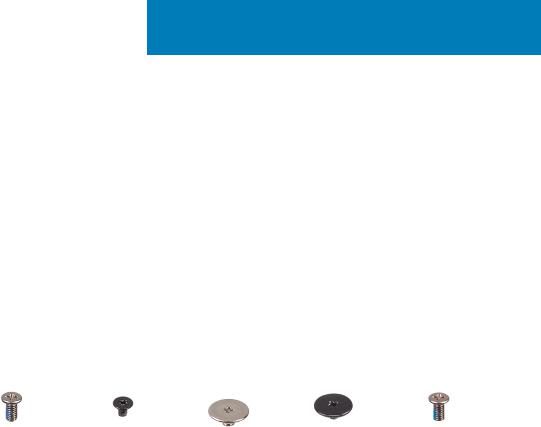
3
Disassembly and reassembly
Recommended tools
The procedures in this document require the following tools:
•Phillips #0 screwdriver
•Phillips #1 screwdriver
•Plastic scribe

 NOTE: The #0 screw driver is for screws 0-1 and the #1 screw driver is for screws 2-4.
NOTE: The #0 screw driver is for screws 0-1 and the #1 screw driver is for screws 2-4.
Screw size list
Table 1. Screw size list
|
M2.5x7 |
M2x3 |
M2.5x2.5 Big |
M2X2 Big Head |
M2.5x5 |
|
Head |
||||
|
|
|
|
|
|
Component |
|
|
|
|
|
|
|
|
|
|
|
Base cover |
7 |
|
|
|
|
|
|
|
|
|
|
Battery |
|
3 |
|
|
|
|
|
|
|
|
|
System board |
|
5 |
|
|
|
|
|
|
|
|
|
M.2 SSD card |
|
1 |
|
|
|
|
|
|
|
|
|
Power switch board |
|
2 |
|
|
|
|
|
|
|
|
|
Audio board |
|
1 |
|
|
|
|
|
|
|
|
|
Power connector port |
|
2 |
|
|
|
|
|
|
|
|
|
Touchpad |
|
1 |
|
6 |
|
|
|
|
|
|
|
Display cable bracket |
|
2 |
|
|
|
|
|
|
|
|
|
IO bracket |
|
2 |
|
|
|
|
|
|
|
|
|
WLAN |
|
1 |
|
|
|
|
|
|
|
|
|
Display assembly |
|
|
|
|
6 |
|
|
|
|
|
|
Base cover
Removing base cover
1.Follow the procedure in Before working inside your computer.
2.To remove the base cover:
a)Loosen the 7 M2.5x7 captive screws that secure the base cover to the computer [1] .
b)Pry the base cover from the recesses at the top edges and continue throughout the system [2].

 NOTE: Use a plastic scribe to pry the base cover from the recesses at the top edges.
NOTE: Use a plastic scribe to pry the base cover from the recesses at the top edges.
Disassembly and reassembly |
15 |
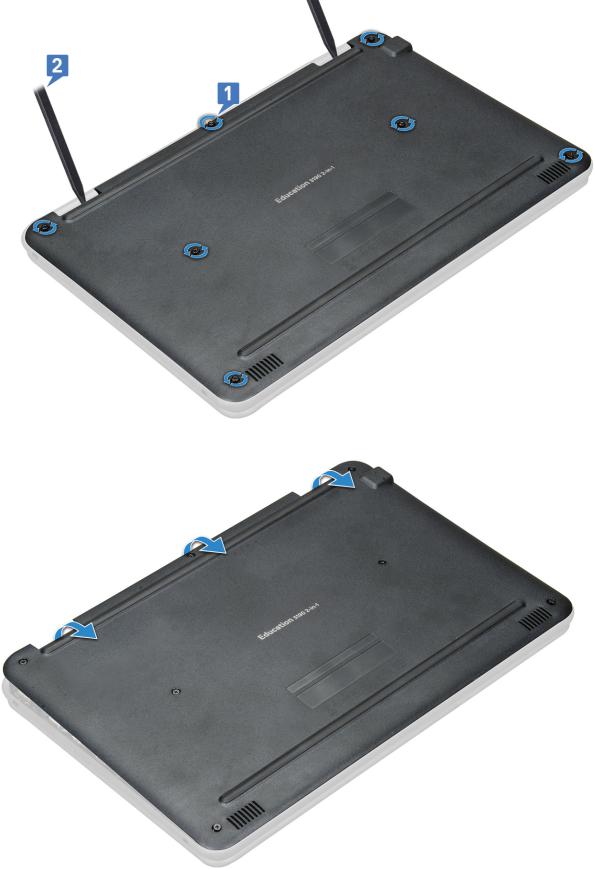
3. Lift the base cover away from the computer.
16 Disassembly and reassembly

Installing base cover
1.Place the base cover to align with the screw holders on the system.
2.Press the edges of the cover until it clicks into place.
3.Replace the 7 M2.5x7 screws to secure the base cover to the computer.
4.Follow the procedure in After working inside your computer.
Battery
Lithium-ion battery precautions
 CAUTION:
CAUTION:
•Exercise caution when handling Lithium-ion batteries.
•Discharge the battery as much as possible before removing it from the system. This can be done by disconnecting the AC adapter from the system to allow the battery to drain.
•Do not crush, drop, mutilate, or penetrate the battery with foreign objects.
•Do not expose the battery to high temperatures, or disassemble battery packs and cells.
•Do not apply pressure to the surface of the battery.
•Do not bend the battery.
•Do not use tools of any kind to pry on or against the battery.
•Ensure any screws during the servicing of this product are not lost or misplaced, to prevent accidental puncture or damage to the battery and other system components.
•If the battery gets stuck inside your computer as a result of swelling, do not try to release it as puncturing, bending, or crushing a lithium-ion battery can be dangerous. In such an instance, contact Dell technical support for assistance. See www.dell.com/contactdell.
•Always purchase genuine batteries from www.dell.com or authorized Dell partners and resellers.
Removing battery
1.Follow the procedure in Before working inside your computer.
2.Remove the:
a)base cover
3.To remove the battery:
a)Disconnect the battery cable from the connector on the system board [1].
b)Remove the three M2x3 screws that secure the battery to the computer [2].
c)Peel off the adhesive tape that secures the battery to the system [3].
d)slightly hold the tape and lift the battery to release it from the adhesive beneath it [4].
Disassembly and reassembly |
17 |

e) Lift the battery from the computer.
Installing battery
1. Insert the battery into the slot on the computer.
18 Disassembly and reassembly
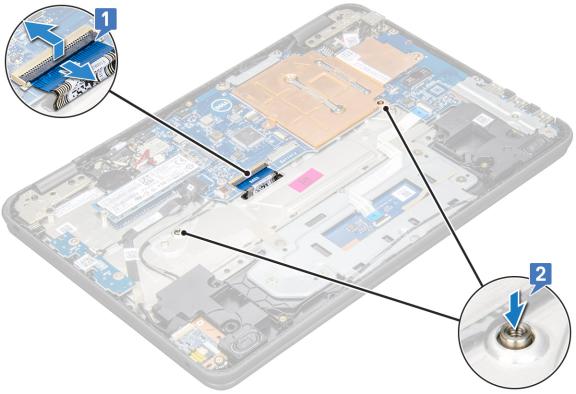
2.Affix the adhesive tapes to secure the battery to the system.
3.Connect the battery cable to the connector on the battery.
4.Replace the three M2x3 screws to secure the battery to the computer.
5.Install the:
a)base cover
6.Follow the procedure in After working inside your computer.
Keyboard lattice and Keyboard
Removing keyboard
1.Follow the procedure in Before working inside your computer.
2.Remove the:
a)base cover
b)battery
3.Disconnect the keyboard cable from the connector on the system board [1].
4.Hold the sides of the palm rest securely while pushing into the two release holes using a plastic scribe or screwdriver [2].
5. Pry the bottom of the keyboard using a plastic scribe to the release the keyboard.
Disassembly and reassembly |
19 |
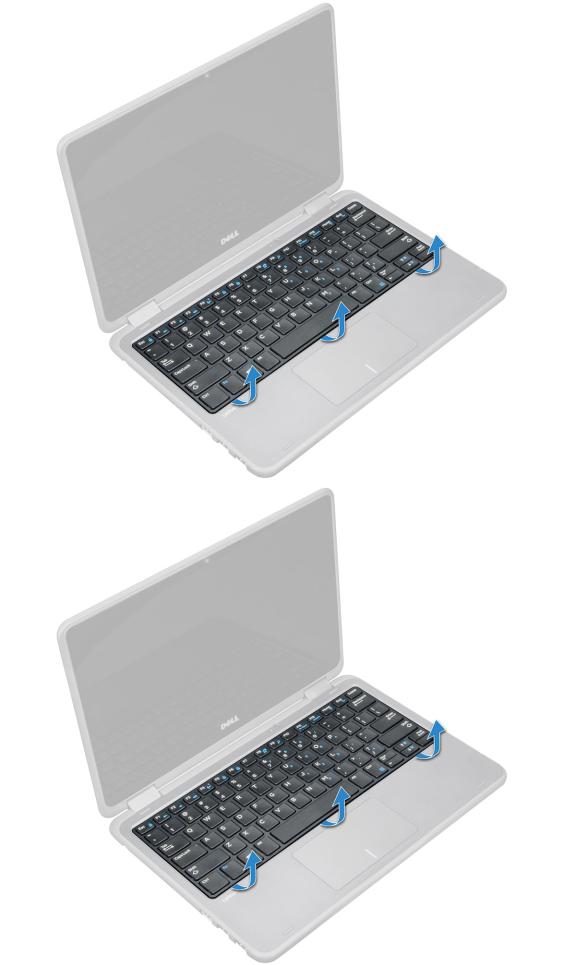
20 Disassembly and reassembly
